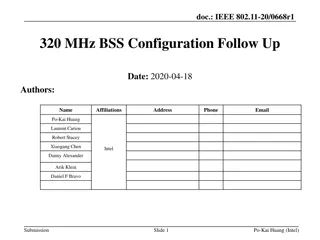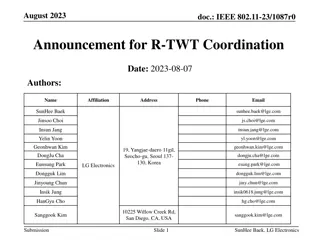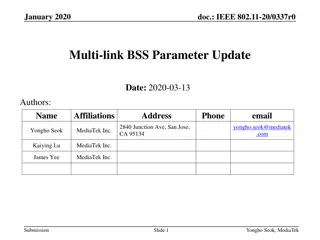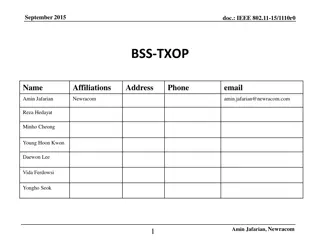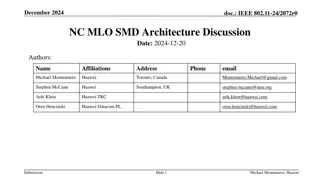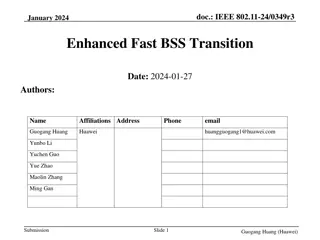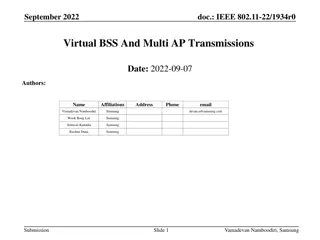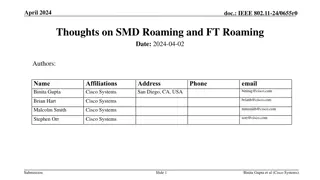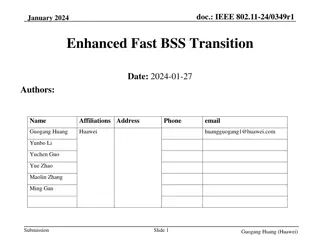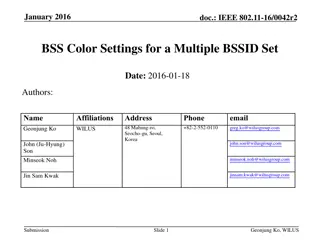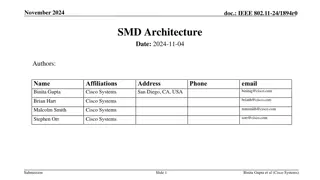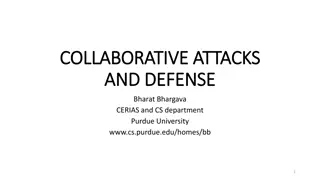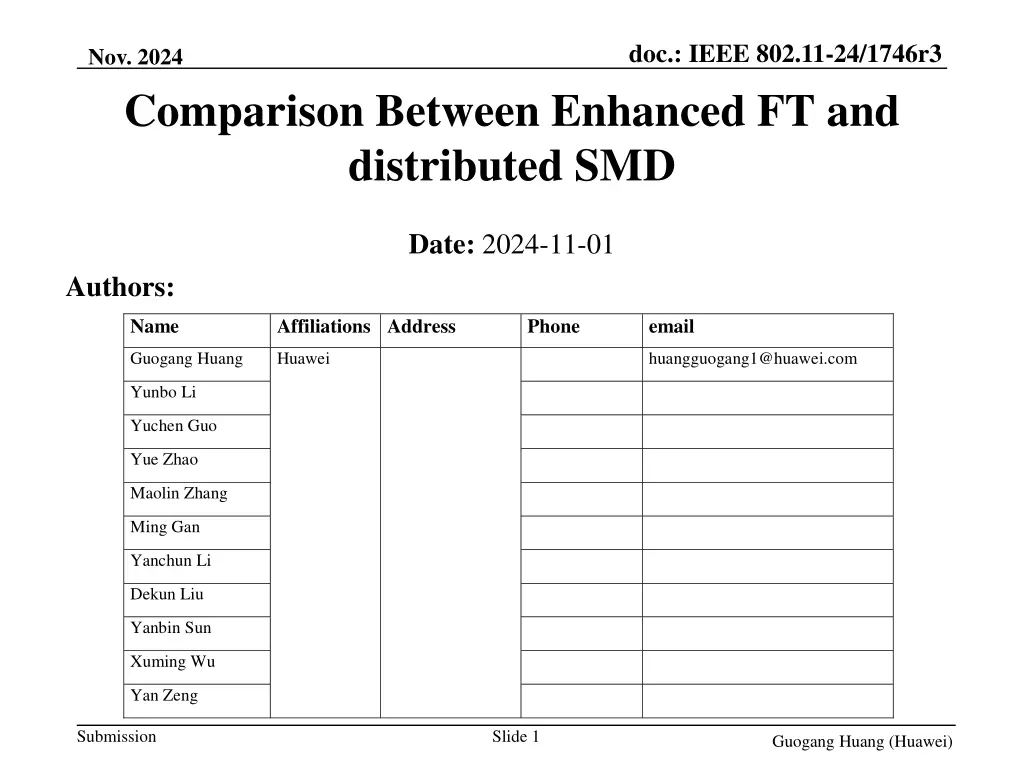
Enhanced FT vs Distributed SMD Comparison
"Explore the comparison between Enhanced Fast BSS Transition (FT) and Distributed Shared Management Data (SMD) in IEEE 802.11 networks. Understand the differences in roaming architecture and security, as well as the proposed improvements for each approach. Dive into the nuances of PTKSA usage and binding in this detailed analysis."
Download Presentation

Please find below an Image/Link to download the presentation.
The content on the website is provided AS IS for your information and personal use only. It may not be sold, licensed, or shared on other websites without obtaining consent from the author. If you encounter any issues during the download, it is possible that the publisher has removed the file from their server.
You are allowed to download the files provided on this website for personal or commercial use, subject to the condition that they are used lawfully. All files are the property of their respective owners.
The content on the website is provided AS IS for your information and personal use only. It may not be sold, licensed, or shared on other websites without obtaining consent from the author.
E N D
Presentation Transcript
doc.: IEEE 802.11-24/1746r3 Nov. 2024 Comparison Between Enhanced FT and distributed SMD Date: 2024-11-01 Authors: Name Affiliations Address Phone email Guogang Huang Huawei huangguogang1@huawei.com Yunbo Li Yuchen Guo Yue Zhao Maolin Zhang Ming Gan Yanchun Li Dekun Liu Yanbin Sun Xuming Wu Yan Zeng Submission Slide 1 Guogang Huang (Huawei)
doc.: IEEE 802.11-24/1746r3 Nov. 2024 Introduction Roaming is one important MAC topic in 11bn. But now there is a fundamental divergence on the roaming architecture and security. Enhanced fast BSS transition (FT), in which different PTKSAs are used when roaming from the current AP MLD to target AP MLD. [1-3] Assuming both current AP MLD and target AP MLD belongs to the same mobility domain (MD) which is identified by a MD ID (2 octets). The PTKSA is bound with each AP MLD itself MAC address and non-AP MLD MAC address. Distributed SMD with PTK sharing, in which the same PTKSA is used and transferred when roaming from the current AP MLD to target AP MLD. [4-5] Assuming both current AP MLD and target AP MLD belongs to the same distributed SMD which is identified by a common MAC address. The PTKSA is bound with this common MAC address and non-AP MLD MAC address. In this contribution, we will provide some detailed comparisons between enhanced FT and distributed SMD with PTK sharing. Submission Slide 2 Guogang Huang (Huawei)
doc.: IEEE 802.11-24/1746r3 Nov. 2024 Enhanced FT In previous contributions [1-3], some candidate improvements are proposed to improve the performance of the current FT protocol, e.g. Improvement 1. Enable the context transfer and data forwarding to avoid the packet loss resulting from flushing the Tx/Rx buffer Reduce layer-2 packet loss Improvement 2. Enable the over-the-DS probing nearby APs which can avoid the transmission rate drop due to the off-channel scanning, especially for the EMLSR non-AP MLD. Simultaneously, define NDPR+NDPA+NDP to realize the RSSI measurement and time synchronization. [6] Improvement 3. Enable the over-the-DS reassociation without DS mapping change (e.g. defining FT Multi-link Setup Request/Response frame exchange) and use another Request/Response Request/Response) to trigger the DS mapping change and the context transfer. Multi-link setup PTK rederivation frame exchange (e.g. Roaming Submission Slide 3 Guogang Huang (Huawei)
doc.: IEEE 802.11-24/1746r3 Nov. 2024 Roaming Through Current AP MLD Distributed SMD MD Target AP MLD DS Current AP MLD Target AP MLD DS Current AP MLD Non-AP MLD Non-AP MLD 11kvr (Optional) 11kvr (Optional) Probe Request Probe Response FT Probe Request FT Probe Response Monitor RSSI with target AP MLD by using a short frame exchange NDPA/NDP) and select a propriate roaming point to change DS mapping and dynamic context transfer by sending Roaming Request. FT Multi-link Setup Request FT Multi-link Setup Response Link Reconfiguration Setup Request (e.g. Link Reconfiguration Setup Response ... ... Roaming Request Roaming Request Context Transfer Request Context Transfer Request DS-STA-NOTIFY .Request (MOVE) DS-STA-NOTIFY .Request (MOVE) Context Transfer Response Roaming Response Context Transfer Response Roaming Response Figure 1. Procedure of over-the-DS enhanced FT Figure 2. Roaming through current AP MLD under distributed SMD Submission Slide 4 Guogang Huang (Huawei)
doc.: IEEE 802.11-24/1746r3 Nov. 2024 Roaming Through Target AP MLD Note. Since the Link Reconfiguration Request is protected, the target AP MLD doesn t know which PTK shall be used to decrypt the received Link Reconfiguration Request frame. Hence, the non-AP MLD shall send an unprotected frame to inform the mapping relationship between TA and non-AP MLD MAC Address. MD A2 A3 Non-AP MLD Target AP MLD DS Current AP MLD Client A1 A4 A5 A6 Data A1-A6 are AP MLDs Authentication-Request Baseline RNR and BTM Query/Req/Resp Discovery phase: Client discovers and gathers basic information of neighboring AP MLDs following baseline procedures. APs do not commit resource ... Authentication-Response STA scans OTA (baseline) Baseline RNR and BTM Query/Req/Resp ... Reassociation Request BTM Query (A4, A5, A6) Roaming preparation phase: Candidate AP MLD set is formed here. Network commits resource Static context txfer Context Transfer Request Static context txfer BTM Request [(A4 [255], A5 [100], A6[0]), VI=T_hold] xx frame DS-STA-NOTIFY .Request (MOVE) Context Transfer Response Reassociation Response Link Reconfiguration Request (add A4) Roaming phase: Client transitions to the target AP MLD. Dynamic context txferred & data path switch Data Data Figure 3. Over-the-air enhanced FT protocol Figure 4. Roaming through target AP MLD under distributed SMD Submission Slide 5 Guogang Huang (Huawei)
doc.: IEEE 802.11-24/1746r3 Bad Backward Compatibility of Distributed SMD Each association between a pair of STAs creates a unique pair of IEEE 802.1X Ports. For the distributed SMD with the PTK sharing, the following questions shall be clarified: Which AP MLD does the UHR non-AP MLD associate with? SMD or a specific AP MLD If the non-AP MLD associates with the SMD, then it conflicts with the above Spec. text. Because each AP MLD will create an IEEE 802.1X Controlled Port when the non-AP LD roams to it. If the non-AP MLD associates with a specific AP MLD, then the PTK shall be derived by using AA (i.e. AP MLD MAC address) and SPA (i.e. non-AP MLD MAC address) The AP MLD always acts as the IEEE 802.1X Authenticator, which is identified by the AP MLD s MAC address, and the non-AP MLD always acts as the IEEE 802.1X supplicant, which is identified by the non-AP MLD s MAC address. In other words, the distributed SMD with the PTK sharing conflicts the IEEE 802.1X protocol, which is outside the scope of the IEEE 802.11 protocol. Submission Slide 6 Guogang Huang (Huawei)
doc.: IEEE 802.11-24/1746r3 Bad Backward Compatibility of Distributed SMD (Cont.) Note that although we already had changed the PTK derivation which bounds with the corresponding MLD MAC addresses instead in 11be, this change is fine. Because each association with an AP MLD still has only one corresponding IEEE 802.1X authenticator, which is identified by the corresponding AP MLD MAC address. However, the distributed SMD with the PTK sharing is totally different from the above case, which requires the same PTKSA which bounds with a common SMD MAC address rather than the IEEE 802.1X authenticator itself MAC Address. In addition, the distributed SMD with the PTK sharing directly challenges the necessity of the current three-level key hierarchy (See next slide). Submission Slide 7 Guogang Huang (Huawei)
doc.: IEEE 802.11-24/1746r3 My Question If the PTK can be shared and bounded with a common MAC address, why not directly use the PMK for the individually address MPDU encryption? In other words, there is no need for the third level key. Figure. Three-level Key Hierarchy The MSK (Master Session Key) is generated between the user device and RADIUS server. The AP does not know the MSK because the AP is not an end point of the EAP authentication protocol. The server delivers the generated MSK to the AP using a RADIUS packet. At this time, the MSK is encrypted using the shared secret between the AP and the server. Then the user device and the AP generate a PMK using the MSK. Comment: the above procedure is very similar to the PTK sharing. Figure. 802.11X association Submission Slide 8 Guogang Huang (Huawei)
doc.: IEEE 802.11-24/1746r3 Bad Backward Compatibility of Distributed SMD (Cont.) There are other cases which requires rekey? For example, Assuming the current AP MLD doesn t support the WUR operation, the target AP MLD supports the WUR operation. Then the non-AP MLD shall rederive a new PTK when roaming to the target AP MLD . Submission Slide 9 Guogang Huang (Huawei)
doc.: IEEE 802.11-24/1746r3 Nov. 2024 Conclusions Compared with the enhanced FT, the distributed SMD with the PTK sharing has no any benefit other than increasing the security risk. 11bn is expected to improve the Wi-Fi security, rather than regression in security. The distributed SMD with the PTK sharing significantly conflicts with the goal of 11bn, i.e. ultra high reliability (UHR). The distributed SMD with the PTK sharing is incompatible with the current IEEE 802.1X and has no easy way to incorporate into the current 802.11 Spec. Suggest that any SP about the same PTKSA or the PTK sharing shall NOT be run before the distributed SMD architecture with the PTK sharing is clearly discussed. Submission Slide 10 Guogang Huang (Huawei)
doc.: IEEE 802.11-24/1746r3 Nov. 2024 References [1] 11-23-1897-00-00bn-thoughts-on-improving-roaming-under-existing-architecture [2] 11-24-0349-03-00bn-enhanced-fast-bss-transition [3] 11-24-0679-04-00bn-thoughts-on-functionality-and-security-architecture-for-uhr- seamless-roaming [4] 11-24-0052-00-00bn-seamless-roaming-details [5] 11-23-2157-02-00bn-seamless-roaming-within-a-mobility-domain [6] 11-24-1414-02-00bn-channel-measurement-based-on-control-frame-exchange Submission Slide 11 Guogang Huang (Huawei)
doc.: IEEE 802.11-24/1746r3 Nov. 2024 SP Do you support in 11bn to improve the existing FT protocol? Note. According to the existing FT protocol, the FTO remains in state 4 during and after roaming to the other AP MLD. Specifically, at the time of receiving a Reassociation Response frame with SUCCESS from the target AP MLD, the FTO shall transition from State 2 to State 4 with the target AP MLD and delete any corresponding PTKSA with the current AP MLD. Submission Slide 12 Guogang Huang (Huawei)


